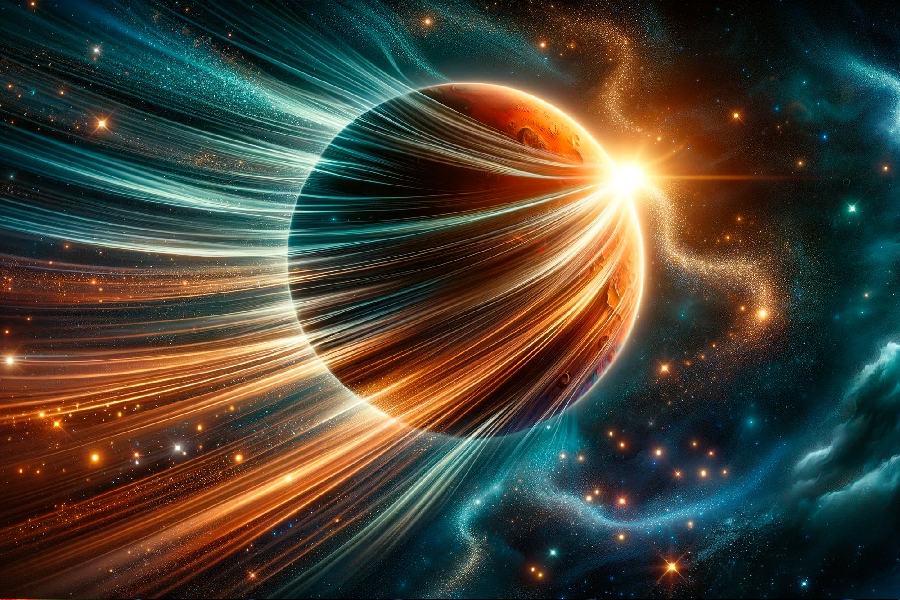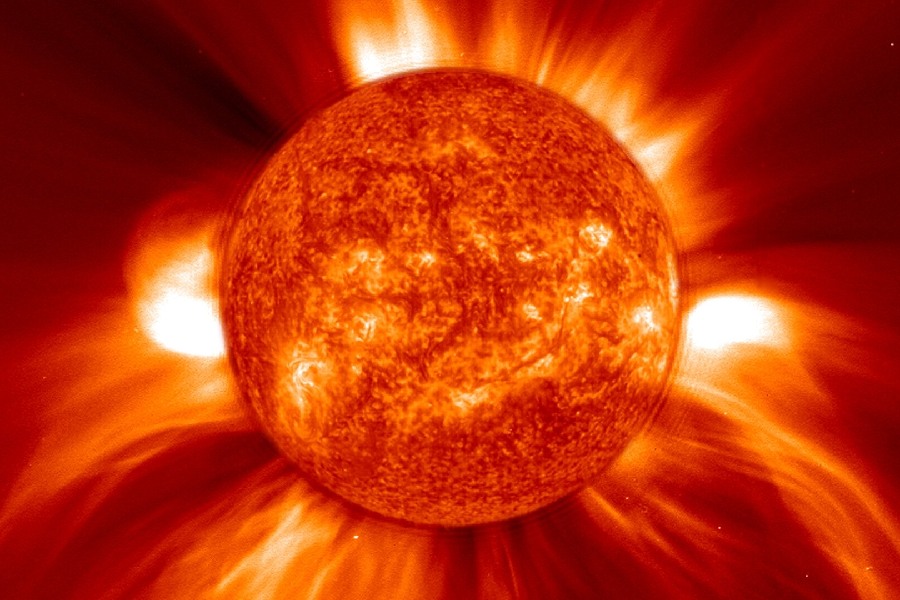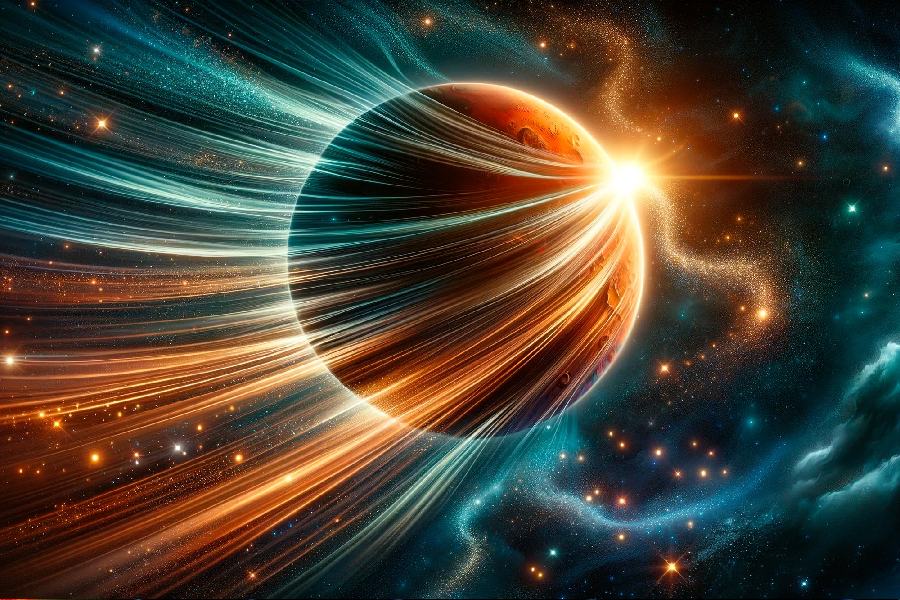The Sun constantly emits a stream of charged particles known as the solar wind that spreads through the solar system. As Earth orbits the Sun, it encounters this wind. But how exactly does this solar weather sweeping from the Sun affect our planet?
In this article, we’ll explore the complex dynamics of the Sun’s gaseous emissions hitting Earth. You’ll learn how the solar wind interacts with layers of our atmosphere and magnetosphere with remarkable impacts – both beautiful and disruptive. We will dive deeper into solar wind effects on Earth and what protects us from its dangers.
The consequences of solar weather reach far and wide across Earth’s natural systems and human infrastructure. Join us as we investigate how our planet stands up to the Sun’s relentless winds and what occurs when mighty solar storms penetrate the planetary defenses.

Solar Wind Effects on Earth
What are the effects of solar wind on Earth? Solar wind, a flow of charged particles from the Sun, affects Earth in diverse ways. It produces vivid auroras near the poles through interactions with atmospheric gases.
However, during heightened activity, it can disrupt communication and power systems by interfering with Earth’s magnetic field. The radiation it carries poses risks to astronauts and satellites.
Additionally, solar wind alters the appearance of comet tails as they interact with its particles, showcasing its impact on celestial phenomena.
Interaction with Earth’s magnetosphere
Earth is surrounded by a magnetic field that extends into space. This area of magnetic influence is known as Earth’s magnetosphere. Many people may want to know why is Earth not affected by solar wind. What shields us from the destruction that solar wind is capable of?
Earth’s magnetosphere acts like a protective shield that deflects most charged particles from the solar wind. This prevents direct bombardment of our atmosphere. Earth’s magnetosphere stretches tens of thousands of miles out into space on the side facing the Sun. It has a magnetotail stretching behind it past the Moon’s orbit.
High speed and dense streams of solar wind can distort Earth’s magnetosphere, compressing it in on the sunward side while stretching the night side. When the direction of the solar wind’s magnetic field matches areas along Earth’s magnetic field lines, reconnection can occur.
This process injects energy into the magnetosphere, often triggering geomagnetic storms. Turbulence in the magnetosphere from solar storms can generate beautiful auroras. However, it may also disrupt satellites and power grids. These disruptions come from solar wind gusts and ejections shaking Earth’s magnetic bubble.
Aurora Borealis and Aurora Australis
The aurora borealis in the north and aurora australis in the south are magical displays of dancing lights in the night sky. Auroras happen when energetic charged particles from space collide with gases in the upper atmosphere, like oxygen and nitrogen.
The gas molecules become excited and release photons as auroral lights when they return to normal. Gusts of energetic solar plasma transfer energy to particles already trapped in Earth’s magnetic field. As these charged particles spiral into the poles and interact with the atmosphere, vibrant auroras emerge.
Variations in the speed and intensity of the solar wind create different shapes, patterns, and intensities of auroral displays. The glowing auroras form shifting oval-shaped bands that circle the north and south poles at high latitudes.
The best places to witness the rippling curtains of auroral light are in high latitudes. These lights have colors like green, red, and purple. Ideal locations to see amazing auroras are Alaska, Canada, Iceland, Greenland, Norway, and Antarctica. However, they can sometimes be glimpsed at lower latitudes.

Solar Wind Particles and Their Effects
Particles in the solar wind’s flow
Along with UV and infrared radiation, the Sun constantly emits a flow of charged particles called plasma carried on solar wind.
This plasma primarily consists of electrons, protons, and heavier ions such as helium nuclei streaming at hundreds of kilometers per second. This solar wind expands far past the planets, eventually dissipating to meet interstellar space. So, how does solar wind affect Earth?
Impacts on Earth’s systems
While most get deflected, solar wind particles can penetrate Earth’s magnetosphere near the poles and interact with atmospheric gases. Particles colliding with oxygen and nitrogen can create dazzling auroral light shows. They also alter the electrically charged ionosphere layer of the atmosphere.
More solar flares and coronal mass ejections send an increased flux of energetic solar wind particles toward Earth. High-velocity solar wind particles and outbursts can damage satellite electronics through surface charging and static build-up.
Geomagnetic storms sparked by solar wind can induce ground currents that trip breakers, causing electrical blackouts and damage to grids. Solar-influenced changes in the ionosphere modify radio wave propagation, at times blocking communication signals.
Space Weather and Solar Storms
Space weather refers to variable conditions in space, driven by solar activity, that can affect Earth and technology. Space weather linked to solar wind causes auroras but also disrupts satellites and power grids.
Solar storms like coronal mass ejections and high solar wind gusts are eruptive emissions from the Sun sending energetic particles to Earth. These particles couple with Earth’s magnetic field, creating geomagnetic storms that pose hazards ranging from satellite issues to blackouts.
Monitoring solar activity aids in predicting space weather to issue warnings. This allows for taking preventative measures against technological disruptions. However, anticipating the complex dynamics defies current models.
Solar Wind Scientific Research and Exploration
Several spacecraft like Ulysses, Genesis, and the Solar and Heliospheric Observatory have studied the solar wind and obtained samples of its particles. Missions such as Advanced Composition Explorer study solar wind as it travels towards Earth.
These missions also probe how it interacts with our planet’s magnetosphere, helping us understand its effects. This daring NASA mission orbits as close as 8.86 million miles to the Sun to trace the origins of the solar wind as intense radiation and heat impact the probe.
Magnetometers on satellites measure magnetic fields carried by solar wind plasma as it passes the spacecraft; changes reveal solar storm activity. Solar wind particle analyzers identify different components of the charged particle streams, including ratios of electrons, protons, and other ions.
Imagers like SOHO’s coronagraph produce pictures of the outer solar atmosphere to visually monitor ejections of solar material on the wind. Ground auroral imagers also display interactions with Earth.
Conclusion
Our exploration of the solar wind effects on Earth reveals its profound influence on the planet, shaping our planet’s environment in diverse ways. From the dazzling auroras to the critical radiation belts, the interaction between charged particles and Earth’s magnetic field paints a vivid picture of this dynamic relationship.
Understanding these solar effects highlights the interconnectedness within our solar system, demonstrating how even a distant star shapes the world we inhabit. This knowledge not only empowers us to anticipate potential threats, like technological disruptions but also deepens our appreciation for the cosmic dance that fosters life on Earth.
By recognizing both the beauty and potential dangers of the solar wind, we gain a deeper understanding of the complex systems that sustain our planet.

